Ansys LS-DYNA Multiphysics Solver: industry-leading explicit simulation software for drop tests, impact and penetration, smashes and crashes, occupant safety, and more.
LS-DYNA fully automated contact analysis capabilities and error-checking features have enabled users worldwide to solve successfully many complex crash and forming problems. LS-DYNA simulation results have been consistently correlated with experimental data at various customer sites. These extensive tests give the user high confidence in using the program as an accurate simulation tool.

Ansys LS-Dyna Main Applications
LS-DYNA has been used in the automotive industry for over 25 years, and its adoption continues to grow. Today, LS-DYNA is the primary crash analysis tool for over 80% of the world’s major automotive OEMs, and the code is used by an estimated 90% of tier 1 suppliers.
The phrase “design-build-test” has been used to accurately describe the traditional automotive development cycle. In recent years, however, the industry has set a new goal of 1-year from concept to reality. With such an aggressive target in mind, design-build-test approach has become increasingly impractical.
LSTC provides a solution to this problem with LS-DYNA, which can be used to replace a significant portion of physical testing with virtual testing. The bottom line is that firms can minimize rebuilding and retesting and ultimately save on development time and cost.
Ansys LS-Dyna Main Applications
- Crash- and pedestrian safety in automotive
- Dummy, airbag, barrier
- Seat belt, retractors
- Automotive part manufacturing
- Car body, seats, roofs, doors
- Hoods, fender, bumpers
- Simulation of manufacturing process
- Deep drawing (incl. gravity sim. and springback)
- Rolling, pressing, forging, casting, spinning
- Superplastic forming, hydroforming, hemming
- Multi-stage processes, metal cutting
- Roller hemming, profile rolling
- Glass forming
- Biomedical applications
- Stability/ failure investigations
- Cranes
- Seat tracks
- Bounce and drop tests
- Mobile phone
- Consumer products
- Tools
- Nuclear vessels
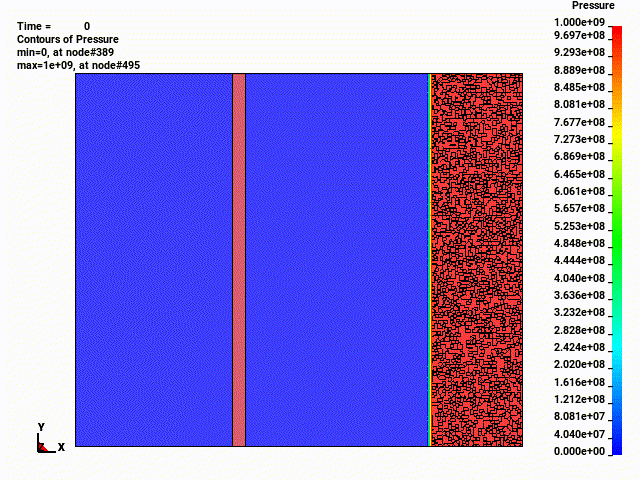
- Earthquake engineering
- Aerospace
- Bird strike
- Jet engine blade containment
- Material behaviour of composites
- Blast loading
- Spot-welded, riveted and bolted structures
- Fluid dynamic
- Fluid-structure interaction
- Shipping containers
- Eigenvalue analysis
- Penetration problems
- Plastics, mold and blow forming
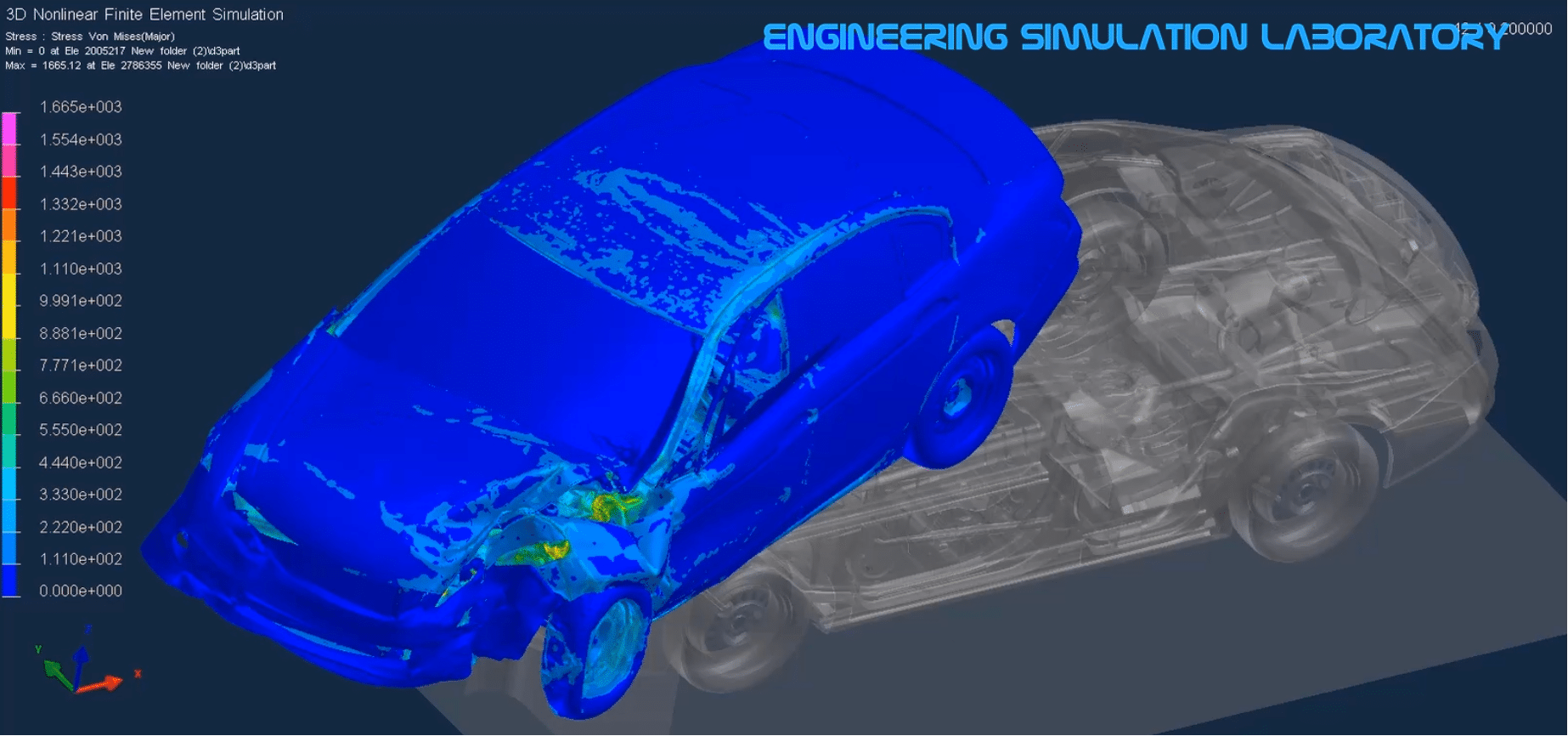
LS-DYNA is already being used for a wide variety of automotive-related simulations. Some of the most common analysis types include:
- FMVSS201 Head Impact
- FMVSS207/210 Seatbelt Anchorage
- FMVSS208 Frontal Impact
- FMVSS214 Static & Dynamic Side Impact
- FMVSS216 Roof Crush
- FMVSS225 Child Restraint Anchorage
- FMVSS301 Rear Impact & Fuel Integrity
- IIHS Offset Frontal Impact
- IIHS Side Impact
- IIHS Low Speed Bumper Impact
- Gravity Loading
- Elastic Recovery After Dynamic Impact
Why Ansys LS-Dyna used for Crash Test and crashworthiness Analysis?
Such analyses encompass a wide variety of complex physical phenomena, and LS-DYNA is equipped with vast array of features and capabilities to replicate these events. These include:
- An extensive library of materials (more than any other code) capable of accurately modeling steel, aluminum, plastics, fabric, glass, rubber, foam, honeycomb, and many others under both static and high-speed dynamic conditions. Many of these material models also capture viscous, rate-dependent, and hyperelastic behavior, and there is a wide variety of both brittle and ductile failure options available.
- An extensive selection of accurate and very general contact algorithms. These include surface-to-surface contacts, eroding contacts, tied interfaces, and many more.
- An extensive selection of airbag modeling tools. Available methods include Control Volume, ALE, and CPM.
- An extensive selection of seat belt related features, including sliprings, retractors, pre-tensioners, and sensors.
- An extensive selection of joining methods. These include rigid connections, bolts, and spotwelds. Delamination of boded structures can also be modeled.
- Multi-physics capabilities to model things like fluid-structure interaction in fuel tanks.
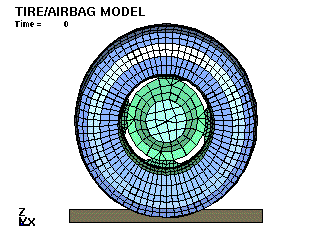
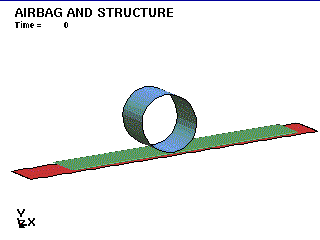

LS-DYNA provides more than 130 metallic and non-metallic material models.
- Elastic
- Metals
- Plastics
- Linear visco-elasticity
- Elasto-viscoplastic
- Elastomers and rubbers
- Glass models
- Foams
- Fabrics
- Composites
- Honeycombs
- Kevlar material with damage
- Equations-of-state hydrodynamic models
- Acoustic pressure material/element
- Concrete & soils
- High explosives
- Propellants
- Viscous fluids
- Biomechanic material models
- Failure models
- User-defined materials
Contact options
The fully automated contact analysis capability in LS-DYNA is easy to use, robust, and validated. It uses constraint and penalty methods to satisfy contact conditions. These techniques have worked extremely well over the past twenty years in numerous applications such as full-car crashworthiness studies, system/component analysis, and occupant safety analysis. Coupled thermo-mechanical contact can also be handled. Over 40 different contacts are available. Multiple contact options are possible, for example:
- Single surface contact
- Contact with rigid walls
- Beam-beam contact
- Tied surfaces
- Nodes tied to surfaces
- Shell edges tied to shell surfaces
- Fluid-structure interfaces
- Eroding contact
- Edge-to-edge contact
- Resultant force contact
- Draw beads
- Pinball contact
- Flexible body contact
- Flexible body to rigid body contact
- Rigid body to rigid body contact
- Sliding contact
- Contact with CAD surfaces
- Heat transfer across the contact surface
- User-defined contact options
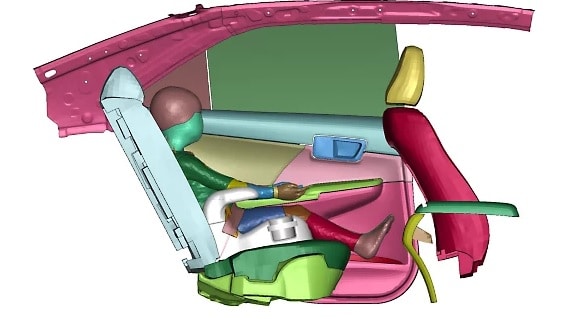
Specialized automotive features
- Seat-belts – including modeling of accelerometer, pretensioner, retractor, sensor, and slip ring
- Inflator models
- Airbag fabric constitutive models
- Accelerometers
- Airbag sensors
- Airbag breakout
- Eulerian deployment of airbags
- Airbag folder
- Unfolded reference geometry for airbags
- Dummy positioner
- Side-impact dummy special damper
- Particle method for airbag deployment
Soil-Dam-Structure Interaction
Large civil structures such as concrete dams, nuclear power plants, high-rise buildings and bridges are massive enough that their vibration due to earthquake excitation affects the motion of the soil or rock supporting them,which in turn further affects the motion of the structure itself. This interaction between the structure and the soil needs to be modeled accurately in order to design earthquake resistant structures and to correctly evaluate the earthquake safety of existing structures.
Earthquake analysis of dams provide an added challenge beyond analysis of soil-structure systems because here there are two unbounded domains — the water and the foundation rock, interacting with each other as well as the dam — as opposed to only one unbounded domain in soil-structure interaction.


Stamping and Forming Manufacturing Simulation with LS-DYNA
LS-DYNA is the most versatile software available commercially, owing to its development strategy of one scalable code that integrates multi-physics, multi-stage, and multi-scale capabilities. Application of LS-DYNA in stamping manufacturing engineering is fully process dependent, limited only by the imaginations of its users, and has proven to be applicable (but not limited) in the following areas:
- Gravity loading (implicit)
- Binder closing/setting (implicit & explicit)
- Forming (thin, thick shells and solids)
- Flanging (think shell & solids, implicit & explicit)
- Hemming (press & roller)
- Springback (free standing or on fixture nets)
- Springback compensation of stamping die and line dies
- Assembly simulation (clamping forces, permanent set, springback, etc.)
- Stoning for surface defects of exterior panels
- Dynamic panel transfer (transfer press line)
- Panel dropping (onto fixture) simulation
- Stamping optimization (draw beads, material properties & tool geometry, etc.)
- Various static & dynamic loading of structures
- Denting and snap-through simulation
- One-step stamping initialization for subsequent process (crash simulation, etc.)
- Stamping scrap shedding process
- Tube-bending/Hydro-forming
- Hot/warm stamping & superplastic forming
- Magnetic metal forming
LSTC has also invested tremendous effort in developing a large collection of dummy and barrier models for use in crash simulations. These models have been correlated with physical test results and are completely free when you purchase LS-DYNA.
Another strength of Ansys LS-DYNA that is critical to the automotive industry is the scalability of the MPP version of the code. With the ability utilize hundreds (or even thousands) of CPUs for a single simulation run, detailed crash analyses that once took days can now be easily turned around in a matter of hours.

WE WORK WITH YOU
We pride ourselves on empowering each client to overcome the challenges of their most demanding projects.
Enteknograte offers a Virtual Engineering approach with FEA tools such as MSC Softwrae(Simufact, Digimat, Nastran, MSC APEX, Actran Acoustic solver), ABAQUS, Ansys, and LS-Dyna, encompassing the accurate prediction of in-service loads, the performance evaluation, and the integrity assessment including the influence of manufacturing the components.
Crash Test and Crashworthiness
Blast Resistance with Protection Against Ballistic Attacks
Seat Design: Finite Element and CFD Simulation for Static & Dynamic Comfort, Whiplash, Acoustic & Thermal Comfort, Crash Test
Structural Dynamics: Coupling CFD, MBD, FEA and 1D Systems Simulation Software
Finite Element Welding Simulation: RSW, FSW, Arc, Electron and Laser Beam Welding
Metal Forming Simulation: FEA Based Design and Optimization
Finite Element Analysis of Durability and Fatigue Life
Simulation for Quenching: Virtual Heat Treatment Optimization
Casting: Finite Element and CFD Simulation Based Design
Additive Manufacturing and 3D Printing
Rotors Aerodynamic Simulation via Coupled FEA (MBD)/CFD Method: Aeroelastic Behavior Assessment
eVTOL (Electric Vertical Take-Off and Landing) & UAM (Urban Air Mobility)
Acoustics and Vibration: FEA and CFD for AeroAcoustics, VibroAcoustics and NVH Analysis
FEA Based Composite Material Design and Optimization: MSC Marc, Abaqus, Ansys, Digimat and LS-DYNA
CFD and FEA in Civil Engineering: Seismic Design, Earthquake, Tunnel, Dam, Concrete Structures and Geotechnical Multiphysics Simulation
Marine and Shipbuilding Industry: Finite Element and CFD Based Simulation and Design
In Silico Medical & Biomedical Device Testing: Finite Element & CFD Simulation and Design, Considering FDA & ASME V&V 40
Electromagnetic Multiphysics FEA & CFD Based Simulation
Integrated Artificial Intelligence (AI) & Machine Learning - Deep Learning with CFD & FEA Simulation
Aerodynamics Simulation: Coupling CFD with MBD, FEA and 1D-System Simulation




